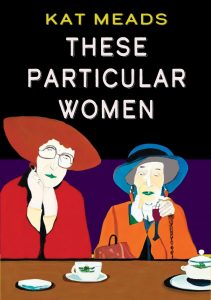After I read the newly published book, These Particular Women – a collection of wonderful and witty essays on famous women writers’ biographers’ surprising contradictions — and I learned that the author of this book is in her early seventies, I knew I needed to interview her for my WOW blog.

That author is Kat Meads, and this is her twentieth published work — in nonfiction, fiction, and poetry. She’s now retired from many years of teaching creative writing in a low-residency graduate program out of Oklahoma City University and is happy to be free to focus on her own writing full time now.

How does she do it? I wanted to know. What keeps her going? What can we all learn from her example, wherever our interests lie? Here is my recent interview with Kat:
BB: What is it about you that might cause another woman to think, “Wow! If she could do this, then maybe I can do it too!”?
KM: I’m from a tiny community in North Carolina that, during my coming of age in the 1950s and 1960s, was entirely rural. My father was a small farmer; my mother, a housewife (and farmer’s assistant). There was no one among the known branches of our family tree who had expressed any interest in writing.
The necessities of life forced the Meadses to focus on more immediate goals that delivered more tangible results. Which is a lengthy way of saying that not even the most reckless gambler would have bet that I’d become a writer. Being stubborn probably helped more than anything. I place a lot of faith in stubbornness.
BB: Oh, so do I! I’m a Taurus, so stubbornness comes with the territory! So what would you say are your biggest (and stubborn-est) accomplishments so far?
KM: Having my work published and read remains a thrill and a wonder, from my first poetry collection, Filming the Everyday, in 1989, to this year’s These Particular Women, a collection of essays about Virginia Woolf, Agatha Christie, Kitty Oppenheimer and other women in the limelight.
But what I’m most grateful for, on a personal level, is continuing to find stuff I want to write about. New projects to grapple with in terms of subject matter and style.
BB: I’m sure it hasn’t been easy. What have been the major obstacles to your achieving your accomplishments?
KM: Time and money. Trying to support myself while at the same time leaving space for my writing. When I was very young, I was more devil-may-care about the bank account; but once middle age set in I had to accept that I needed a bit of a cushion, monetarily, plus healthcare insurance of some sort. It was always a challenge, balancing the “money work,” as I called it, and the work I cared about.
BB: How did you manage to overcome those obstacles?
KM: Along the way I was able to piece together a combination of jobs—temporary secretary-ing, dog grooming, business reporting, teaching—that paid the rent versus employment that required my full-time presence and commitment, so I safeguarded my own writing time.
Insomnia also helped. I taught for a decade in Oklahoma City University’s low-residency MFA program, and most of my mentoring was accomplished by email. My students became very used to finding in their morning inboxes feedback sent from me at 2:30 a.m., Pacific Standard Time. Soon they worried if they didn’t get an email from me posted at that ungodly hour.
BB: Now to the question I must ask everyone — What motivates you?
KM: As I mentioned earlier, I come from a small community in North Carolina. And because my mother lived until she was ninety, I kept returning to that community and my childhood home for almost forty years after I’d “officially” moved away. As a writer, the long-term connection was an enormous gift. It gave me access to not just one story but generational stories and a close-up view of the massive political, social and territorial changes that were taking place in my home county.
I felt a deep obligation to write about that material, and that feeling of obligation became the driving force behind my Mawatuck County trilogy (The Invented Life of Kitty Duncan, when the dust finally settles, In This Season of Rage and Melancholy), novels that deal with fundamentalist religion, segregation, the loss of family farms, real estate development and severely limited opportunities for women.
BB: Ah, yes. And what sustains you on your writing journey?
KM: In my writing practice, writing in multiple genres. If I feel my interest sagging on the prose front, I might switch over to working on a short play. It’s all writing—so there’s still the joy of composing—but switching around, I find, refreshes my brain and energy.
BB: And last but not least – What have you found to be some of the advantages (if any) of advanced age?
KM: Oh, I suspect I share with many women the pure delight that comes, at this point, with not caring in the least what anyone else has to say about my current (and previous) life choices. And of course there’s the advantage, having been around the block a few times, of gaining the broader perspective and realizing the baggage of one’s history that once felt so cripplingly oppressive can also, in retrospect, have its comforts.
~ ~ ~ ~ ~ ~ ~ ~ ~ ~ ~
Kat Meads’ work has been recognized by a National Endowment for the Arts Fellowship, a California Artist Fellowship, two Silicon Valley artist grants and artist residencies at the Fine Arts Work Center in Provincetown, Yaddo, Millay, Dorland, and the Montalvo Center for the Arts. Her short plays have been produced in New York, Los Angeles, Berkeley, and elsewhere. Please visit her website for more: www.katmeads.com .
